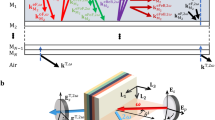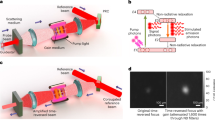Abstract
Three-wave mixing in nonlinear materials—the interaction of two light waves to produce a third—is a convenient way of generating new optical frequencies from common laser sources. However, the resulting optical conversion yield is generally poor, because the relative phases of the three interacting waves change continuously as they propagate through the material1. This phenomenon, known as phase mismatch, is a consequence of optical dispersion (wave velocity is frequency dependent), and is responsible for the poor optical conversion potential of isotropic nonlinear materials2. Here we show that exploiting the random motion of the relative phases in highly transparent polycrystalline materials can be an effective strategy for achieving efficient phase matching in isotropic materials. Distinctive features of this ‘random quasi-phase-matching’ approach are a linear dependence of the conversion yield with sample thickness (predicted in ref. 3), the absence of the need for either preferential materials orientation or specific polarization selection rules, and the existence of a wavelength-dependent resonant size for the polycrystalline grains.
This is a preview of subscription content, access via your institution
Access options
Subscribe to this journal
Receive 51 print issues and online access
$199.00 per year
only $3.90 per issue
Buy this article
- Purchase on Springer Link
- Instant access to full article PDF
Prices may be subject to local taxes which are calculated during checkout



Similar content being viewed by others
References
Armstrong, J. A., Bloembergen, N., Ducuing, J. & Pershan, P. S. Interactions between light waves in a nonlinear dielectric. Phys. Rev. 127, 1918–1939 (1962)
Rosencher, E. & Vinter, B. Optoelectronics (Cambridge Univ. Press, Cambridge, 2002)
Morozov, E. Y., Kaminskii, A. A., Chirkin, A. S. & Yusupov, D. B. Second optical harmonic generation in non linear crystals with a disordered domain structure. JETP Lett. 73, 647–650 (2001)
Fejer, M. M. Nonlinear optical frequency conversion. Phys. Today 40, 25–32 (1994)
Ebrahimzadeh, M. & Dunn, M. H. Parametric generation of tunable light from continuous-wave to femtosecond pulses. Science 286, 1513–1517 (1999)
Fiore, A., Berger, V., Rosencher, E., Bravetti, P. & Nagle, J. Phase matching using an isotropic nonlinear optical material. Nature 391, 463–466 (1998)
Rosencher, E. et al. Quantum engineering of optical nonlinearities. Science 271, 168–173 (1996)
Levi, O. et al. Difference frequency generation of 8-µm radiation in orientation-patterned GaAs. Opt. Lett. 27, 2091–2093 (2002)
Eyres, L. A. et al. All-epitaxial fabrication of thick, orientation-patterned GaAs films for nonlinear optical frequency conversion. Appl. Phys. Lett. 79 (2001)
Fejer, M. M., Magel, G. A., Jundt, D. H. & Byer, R. L. Quasi-phase-matched second harmonic generation: tuning and tolerances. IEEE J. Quant. Electron. 28, 2631–3654 (1992)
Agranovitch, V. M. & Kravtsov, V. E. Nonlinear backscattering from opaque media. Phys. Rev. B 43, 13691–13694 (1991)
Kravtsov, V. E., Agranovitch, V. M. & Grigorishin, K. I. Theory of second-harmonic generation in strongly scattering media. Phys. Rev. B 44, 4931–4942 (1991)
Makeev, E. V. & Skipetrov, S. E. Second harmonic generation in suspensions of spherical particles. Opt. Commun. 224, 139–147 (2003)
Mel'nikov, V. A. et al. Second-harmonic generation in strongly scattering porous gallium phosphide. Appl. Phys. B 79, 225–228 (2004)
Wiersma, D. S. & Cavalieri, S. A temperature-tunable random laser. Nature 414, 708–709 (2002)
Kurtz, S. K. & Perry, T. T. A powder technique for the evaluation of non linear optical materials. J. Appl. Phys. 39, 3798–3813 (1968)
Shoji, I., Kondo, T., Kitamoto, A., Shirane, M. & Ito, R. Absolute scale of second-order nonlinear-optical coefficients. J. Opt. Soc. Am. B 14, 2268–2294 (1997)
Rzepka, E., Roger, J. P., Lemasson, P. & Triboulet, R. Optical transmission of ZnSe crystals grown by solid phase recrystallisation. J. Cryst. Growth 197, 480–484 (1999)
Haidar, R. et al. Largely tunable mid-infrared (8–12 µm) difference frequency generation in isotropic semiconductors. J. Appl. Phys. 91, 2550–2552 (2002)
Vodopyanov, K. L. et al. Optical parametric oscillation in quasi-phase-matched GaAs. Opt. Lett. 29, 1912–1914 (2004)
Acknowledgements
We are indebted to C. Sanchez and A. Cheniere for X-ray measurements, A. Godard, M. Lefebvre and N. Guérineau for help, to M. Fejer for discussions, and D. Sessler for critical reading of the manuscript. This work was supported by the Délégation Générale pour l'Armement (DGA).
Author information
Authors and Affiliations
Corresponding author
Ethics declarations
Competing interests
The authors declare that they have no competing financial interests.
Rights and permissions
About this article
Cite this article
Baudrier-Raybaut, M., Haïdar, R., Kupecek, P. et al. Random quasi-phase-matching in bulk polycrystalline isotropic nonlinear materials. Nature 432, 374–376 (2004). https://doi.org/10.1038/nature03027
Received:
Accepted:
Issue Date:
DOI: https://doi.org/10.1038/nature03027
This article is cited by
-
Dispersion-flattened femtosecond mid-IR Cr:ZnS laser with a passive optical switch based on graphene–ZnSe
Journal of the Korean Physical Society (2023)
-
Storing and retrieving multiple images in 3D nonlinear photonic crystals
Light: Science & Applications (2021)
-
Influence of electric field on SHG properties of LN/PMMA nanocomposites
Applied Physics B (2021)
-
Broadband Mie driven random quasi-phase-matching
Nature Photonics (2020)
-
Optoelectronic parametric oscillator
Light: Science & Applications (2020)
Comments
By submitting a comment you agree to abide by our Terms and Community Guidelines. If you find something abusive or that does not comply with our terms or guidelines please flag it as inappropriate.



